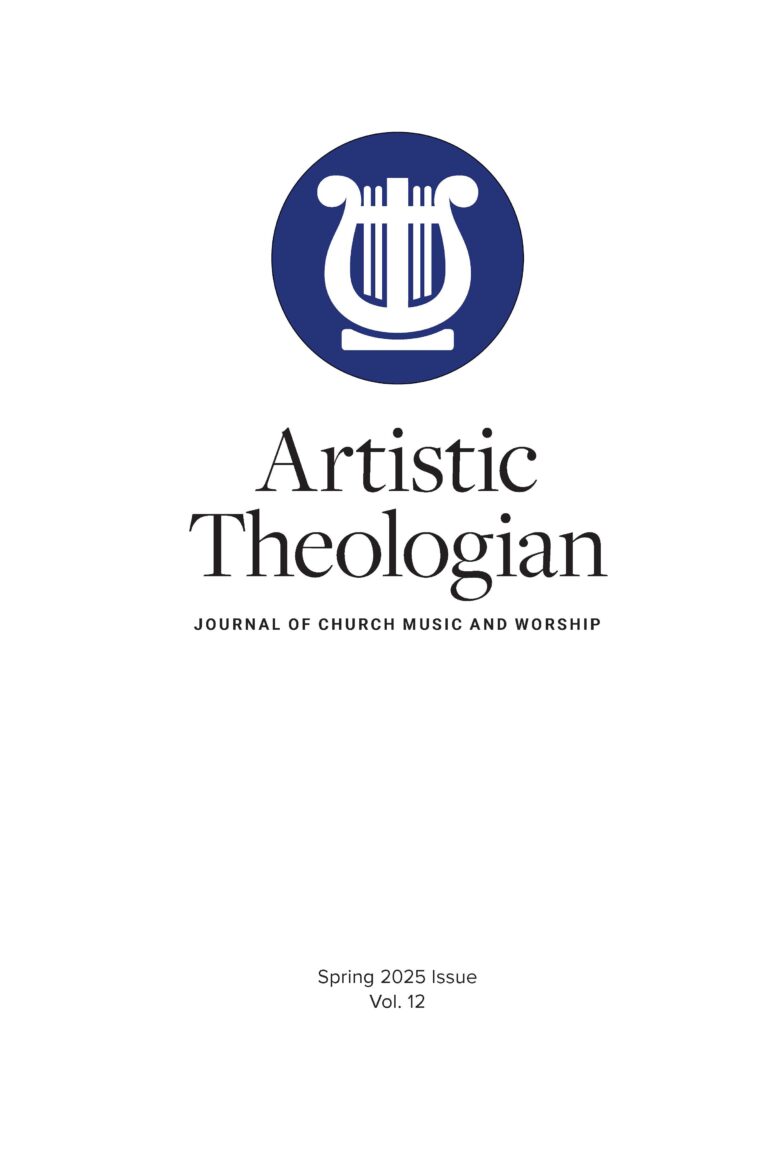
Cowden Hall’s Cornerstone Verse: Colossians 3:16
Artistic Theologian
Volume 12
Spring 2025
Editor: Joshua A. Waggener
Fenner, Chris, and Brian G. Najapfour, eds. Amazing Love! How Can It Be: Studies on Hymns by Charles Wesley. Eugene, OR: Resource Publications, 2020. 193 pp. $25.20
Chris Fenner, digital archivist at The Southern Baptist Theological Seminary and managing editor of HymnologyArchive.com, and Brian G. Najapfour, pastor of the Heritage Reformed Congregation of Jordan, Ontario, edited this work on the hymns of Charles Wesley.
Each essay in this volume incorporates “integrated” dimensions of hymn analysis, as proposed by Scotty Gray in Hermeneutics of Hymnody: A Comprehensive and Integrated Approach to Understanding Hymns (Smith & Helwys, 2015). The essays also provide the hymn in its complete original form and note significant textual variations in subsequent publications (x). The goal of the authors is to spiritually encourage the reader, as well as provide a “deeper understanding of the ‘amazing love’ responsible for changing the course of Charles Wesley’s life, who in turn changed the course of Christian worship” (x).
The book is divided into various theological and liturgical sub-sections to organize the twelve essays on particular hymns. The first section contains three hymns about conversion. Najapfour begins the essays by analyzing the hymn Wesley wrote two days after his conversion, “Where shall my wondering soul begin?” (3). Najapfour highlights the scriptural background for the hymn, including Isaiah 43:1–3. He also emphasizes the importance of “knowing” and “feeling” for Methodist spirituality in the lines “Should know, should feel my sins forgiv’n, Blest with this antepast of heav’n!” (5). In chapter 2, Steve Weaver analyzes “And can it be that I should gain,” another hymn closely associated with Wesley’s conversion experience. Weaver recounts how Wesley studied Martin Luther’s commentary on Galatians just days before his conversion. Galatians 2:20 seems to form a basis for the first stanza of “And can it be that I should gain,” as well as the repeated emphasis of Christ dying “for me” throughout the hymn (14). Next, Jonathan Powers succinctly and helpfully discusses the theological, lyrical, and biographical aspects of “O for a thousand tongues to sing,” which was originally titled “For the Anniversary Day of One’s Conversion” (19).
The second section considers two hymns about struggle and respite. In chapter 4, Patrick Eby and Christopher McFadden investigate “Jesu, lover of my soul” through a practical lens. This hymn is one which gives us “a set of tools to examine and explore the tensions of our lives,” such as “the tension of living out the Christian faith in times of struggle and temptation” (30–31). Perhaps inspired by Wesley’s stormy trips across the Atlantic, “Jesu, lover of my soul” employs imagery of the storm, the place of refuge, and the refuge of God’s wings (31). Michael Hawn writes chapter 5 on a prayer-focused hymn, “Come, O thou traveller unknown (Wrestling Jacob).” Hawn provides historical commentary on Wesley and Watts (36, 39). He also combines biblical and poetic analysis in his discussion of allegory (37) and paradox (40).
The third section gives attention to three hymns celebrating the incarnation and resurrection of Christ. Josh Dear analyzes the two-stanza Christmas hymn “Come, Thou long-expected Jesus” in chapter 6. Dear believes this hymn has a “multi-layered purpose” of reminding us of the eager anticipation of the ancient Israelites awaiting the Messiah’s arrival on earth and the “even greater anticipation” we have now awaiting the final return of Jesus (52). In chapter 7, Fenner discusses how the textual alterations to “Hark! The herald angels sing” have helped this hymn, which is “rich with Scripture,” to endure as a beloved Christmas carol (63). Joe Harrod systematically analyzes the theology and poetic devices in each of the original eleven stanzas of “Christ the Lord is ris’n today” in chapter 8. This analysis leads Harrod to remark that the “breadth of theological loci within the hymn is striking,” as it touches on Christology, hamartiology, soteriology, and eschatology (70).
The fourth section addresses three hymns on ordinances and sanctification. Fenner focuses on the theological importance of “The Means of Grace” in chapter 9. In this hymn, Charles Wesley argues against both the “intensive, works-oriented” mindset of William Law on the one hand, and the antinomianism of some of the English Moravians on the other hand (74). Paul Chilcote examines the sacramental hymn “O the depth of love divine” in chapter 10. This hymn explicates the mysterious “presence of God in the Sacrament” of the Lord’s Supper (82), the “power of the Holy Spirit” working through the sacrament (83), the “perfection,” or sanctification of the believer (84), and the unification of the church community (84). Whereas “The Means of Grace” is focused on salvation, and “O the depth of love divine” is focused on the Lord’s Supper, “Love divine, all loves excelling” is focused on Wesley’s “ongoing concern for holiness” (86). Roger Duke and Fenner discuss the origin of “Love divine, all loves excelling” as a parody of Dryden’s poem “Fairest Isle, all isles excelling” from Purcell’s King Arthur (87). In its original form, the hymn espoused the Wesleys’s early shared belief that Christians could achieve perfect sanctification in this life. Yet Charles eventually came to believe that “complete sanctification only happened on the other side of death” (89), which pitted him against his brother for some time. Many modern hymnals have printed alterations such as “take away the love of sinning” (93) to avoid perfectionism.
In a final section, Michael Haykin analyzes the hymn “Sun of unclouded righteousness.” This hymn is a Trinitarian prayer for the conversion of “the Mahometans,” or Muslims (100). In chapter 13, Margaret Garrett discusses the operatic influences on the hymns tunes used by John and Charles Wesley. According to Garrett, Mrs. Priscilla Stevens Rich introduced the Wesleys to many prominent composers, including George Frideric Handel and John Frederick Lampe. In the final chapter, Jim Scott Orrick discusses some of the enduring qualities of Wesley’s hymns, including the “variety of topics” that are like a “treasure chest full of differing jewels” (133).
Although there is insightful analysis in every chapter, the authors avoid criticisms of Wesley’s texts. For example, Weaver discusses the meaning of kenosis, or “self-emptying” of Christ (Phil. 2:5–8), in stanza three of “And can it be that I should gain.” Yet he does not address the theological criticism this stanza has received or any of the lyrical substitutions for “Emptied himself of all but love.” Avoiding historical controversy seems to be a deliberate editorial choice to focus on the positive contributions of these twelve hymns.
This book models thoughtful application of Gray’s method of integrated hermeneutics of hymnody. Most chapters contain a depth of analysis that will benefit future scholarship on Wesley hymns. Musicians will be enriched as they encounter these beloved hymn texts paired with tunes to which Charles and his contemporaries would have sung them provided in the appendix (139–75). Furthermore, any Christian can read the relatively short independent chapters and receive spiritual encouragement from the theological and devotional insight.





